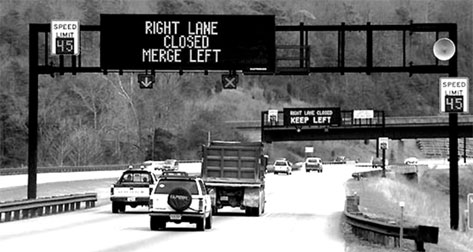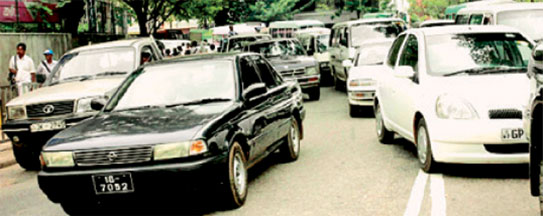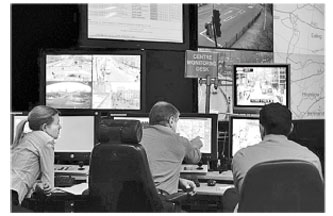ITS – for a better transport system
By Lionel WIJESIRI

An Intelligent Transport System

A traffic jam |
Sri Lanka would face a crisis when the number of vehicles in the
country reaches five million by the end of the year with limited road
capacity, Deputy Minister of Transport Rohana Kumara Dissanayake told
Parliament recently. He said that statistically, one out of four
families owned a vehicle today. He said that the Government had
identified the impending problem and had increased the import duty of
vehicles to discourage imports.
Getting caught in a traffic jam often brings out the worst in most of
us. We blame bad drivers, poor road conditions, burgeoning traffic,
absence of a mass rapid transport system and unbridled urbanisation for
the troubles we face while navigating a city road. While all these may
have contributed to the urban road chaos, seldom do we stop to consider
why things aren’t changing despite the vast amounts of money being
invested in transport infrastructure.
Besides increasing traffic congestion, urban areas are also faced
with several other transport-related problems such as the increasing
emission of pollutants and depleting fuel resources that adversely
impact the overall well-being of any major city. Studies have shown that
an effective transport system is important for a city’s economic
competitiveness and severe congestion is known to have a negative impact
on GDP.
To make transport management more effective, several cities across
the world are trying to build intelligence into existing systems.
Transport management systems and software tools have been effective to
curtail traffic woes around some mega cities of the world. For example,
in London, a congestion management system has lowered traffic volumes to
mid-1980s levels. The system in Singapore can predict traffic speeds
with nearly 90 percent accuracy. With future enhancements, the system
will help predict - rather than merely monitor - other traffic
conditions as well.
Solutions
Although Intelligent Transport Systems (ITS) have been around for
some time, the new generation of solutions offers features such as
traffic prediction, analytics and decision support, traveller
information, advisory services, ticketing and fare collection.
Innovative tools such as roadside sensors, radio frequency tags and
global positioning systems also help monitor and manage transport more
effectively.
For example, traffic prediction helps multi-modal planning whereby
transport services can be integrated to provide seamless and efficient
movement of people. Analytics and decision support helps in continuous,
system-wide performance measurements that help provide optimal solutions
to a city’s dynamic transport needs. Providing integrated ticketing and
fare collection enhances commuter comfort by integrating rail, bus and
parking fares.
Sustained research across cities has revealed that an intelligent
transport system is much more than just discrete software solutions. It
is about adopting user-centric approaches that create a shift in their
attitudes to cost, value and use of transport systems. That is why
leading cities worldwide are using these technologies to implement
transport strategies and create holistic transport solutions that
address three key strategies: governance, transport network optimisation
and integrated transport services.
Information technology
|

A traffic control centre |
Information technology (IT) has transformed many industries, from
education to healthcare to government, and is now in the early stages of
transforming transportation systems. While many think improving a
country’s transportation system solely means building new roads or
repairing ageing infrastructure, the future of transportation lies not
only in concrete and steel, but also increasingly in using IT. IT
enables elements within the transportation system - vehicles, roads,
traffic lights and message signs - to become intelligent by embedding
them with microchips and sensors and empowering them to communicate with
each other through wireless technologies. In the leading nations, IT
Systems bring significant improvement in transportation system
performance, including reduced congestion and increased safety and
traveller convenience.
Unfortunately, in this context, Sri Lanka lags most of the other
Asian countries in ITS deployment. For the most part, this has been the
result of two key factors: a continued lack of adequate funding for ITS
and the lack of the right organisational system to drive ITS in Sri
Lanka, particularly the lack of a scientific approach that has prevailed
to date.
Groups
Intelligent transportation systems include a wide and growing suite
of technologies and applications. ITS applications can be grouped within
five summary categories:
* Advanced Traveller Information Systems provide drivers with
real-time information, such as transit routes and schedules; navigation
directions; and information about delays due to congestion, accidents,
weather conditions or road repair work.
* Advanced Transportation Management Systems include traffic control
devices such as traffic signals, ramp meters, variable message signs,
and traffic operations centres.
* ITS-Enabled Transportation Pricing Systems include systems such as
electronic toll collection (ETC), congestion pricing, fee-based express
(HOT) lanes, and vehicle miles travelled (VMT) usage-based fee systems.
* Advanced Public Transportation Systems, for example, allow trains
and buses to report their position so that passengers can be informed of
their real-time status (arrival and departure information).
Fully integrated intelligent transportation systems, such as
vehicle-to-infrastructure (VII) and vehicle-to-vehicle (V2V)
integration, enable communication among assets in the transportation
system, for example, from vehicles to roadside sensors, traffic lights,
and other vehicles.
ITS delivers five key classes of benefits by:
* Increasing safety,
* Improving operational performance, particularly by reducing
congestion,
* Enhancing mobility and convenience,
*Delivering environmental benefits,
* Boosting productivity and expanding economic and employment growth.
In short, ITS maximises the capacity of infrastructure, reducing the
need to build additional highway capacity. For example, research has
found that by applying real-time traffic data to US traffic signal
lights, traffic flow can improve significantly, reducing stops by as
much as 40 percent, reducing travel time by 25 percent, cutting gas
consumption by 10 percent (1.1 million gallons of gas annually), and
cutting emissions by 22 percent (cutting daily carbon dioxide emissions
by 9,600 tons).
Issues
Whether it’s with regard to ITS systems or those that can be deployed
locally that face systemic barriers, many countries under-invest in ITS.
This happens, in part, because transportation funding is often
allocated without consideration of performance, giving transportation
planners little incentive to preference investments that can have a
maximum impact on optimising system performance.
Another part of the problem is that State and local transportation
agencies were created to build and maintain infrastructure, not to
manage transportation networks, and thus see themselves as “builders of
pieces” and not “managers of a system” and therefore place more emphasis
on building new roads than ensuring the system functions optimally.
Apart from being generally under-funded, another challenge for ITS
projects is that they often have to compete for funding with
conventional transportation projects - fixing potholes, repairing roads
and building new ones - that may be more immediately pressing, but don’t
deliver as great long-term returns.
ITS faces a range of institutional and organisational barriers,
including limited understanding of the technology and jurisdictional
challenges, such as which level of government - Central or Provincial -
has responsibility for or jurisdiction over ITS deployments.
While intelligent transportation systems face a number of challenges,
none of them is insurmountable, and many nations have overcome them.
The potential of ITS has encouraged many developing countries to make
them an integral part of the Common Transport Policy, with the aim of
establishing a co-ordinated infrastructure for ITS.
Traffic management has been a challenge in Sri Lanka and continues to
become more difficult with every passing day. It cannot be addressed
only by constructing new roads, bridges and underpasses.
The solution lies in taking an integrated approach to traffic
management and leveraging advanced technologies and intelligent
solutions. |

